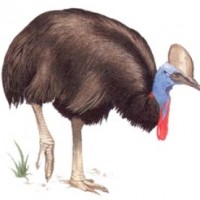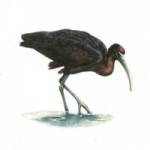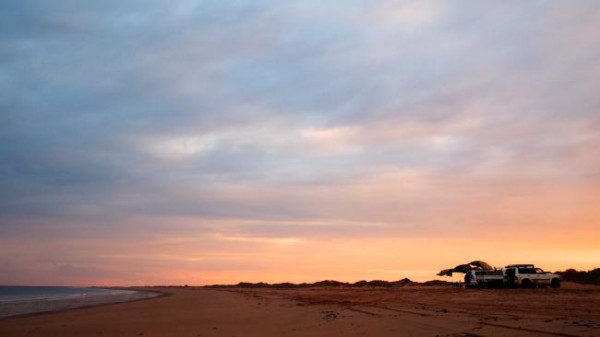Казуар
9 Февраль, 2011
 Казуары (Casuarius Brisson) – the only genus of large flightless birds of the family kazuarovyh, Neg. казуарообразных, living in tropical forests in north-eastern Australia. His name cassowary received from the Indonesian language, translated from the cassowary which means «horned head».
Казуары (Casuarius Brisson) – the only genus of large flightless birds of the family kazuarovyh, Neg. казуарообразных, living in tropical forests in north-eastern Australia. His name cassowary received from the Indonesian language, translated from the cassowary which means «horned head».
Cassowaries belong to a subclass of birds ratites, which belong to the same emu, rhea, Ostriches, moa and kiwi. At present, the genus includes the cassowaries 3 subspecies:
* Shlemonosny cassowary – Casuarius Casuarius
* Cassowary-muruk – Casuarius bennetti
* Oranzhevosheyny cassowary – Casuarius unappendiculatus
Cassowaries are found in tropical forests of New Guinea and northeastern Australia. Ranges of all 3 species partially overlap, Although different subspecies of cassowaries avoid meetings, preferring to settle in different areas.
So oranzhevosheyny cassowary lives mostly in lowland forests, shlemonosny cassowary at medium altitudes, muruk and in mountain forests. In areas, which does not come across other types of, muruk may descend to an altitude of sea level.
Казуары – large flightless birds, mature individuals shlemonosnogo cassowary to reach up to 1,5-1,8 m in height and weigh around 60 kg. because most large cassowary birds in Australia and the second largest bird in the world, after the ostrich.
All 3 subspecies have cassowaries outgrowth on the head, called a helmet. The helmet consists of a horny substance range of solid material, having a sponge-like structure. There are several versions of the functions of the helmet. Perhaps it is a secondary sexual characteristics, for a different version kazury helmet use for, order to make its way through the underbrush when running. Probably to the same, that cassowaries use it as a weapon in fights for dominance or as a tool for raking fallen leaves in search of food. Last 3 Version challenged biologists, and some make the assumption, that helmets play a role in dealing with audio signals. This assumption is made on the basis of, that particular measure, and muruk shlemonosny cassowary publish low-frequency sounds, which can be a means of communication in dense tropical forests.
Plumage black cassowaries, feathers lack hooks, which gives the elasticity of the pen. As a result, cassowaries and emu feathers are more flexible and soft, than most other birds. Cassowaries rudimentary wings, with reduced flight feathers to 5-6, Needle-like, trunks (from 6 before 20 centimeters in size in adult birds). Finger on the main wing claw is – legacy of primitive amphibians. The tail feathers have no cassowaries. Samko cassowary krupnee samcov, more brightly colored and have a big helmet. Young birds have brown plumage, they do not have bright colors on the neck, and the growths on his head is much less, than in adult birds. Legs strong kazurara, three-toed, have sharp claws, kinzhaloobrazny internal claw finger has a length in the 120 millimeters. This claw is particularly dangerous, because they cassowary can kill with one blow. Cassowary can reach speeds of up to 50 km / h when running through the dense forest, able to jump to 1,5 m in height and a good swim. All cassowaries secretive birds and are found deep in the woods. Hiding long before the emergence of human.
Due to the hidden life, and cassowary cassowary oranzhevosheyny-muruk are not well understood. Except for the mating season, cassowaries live alone. Major part of the time, cassowaries spend searching for food, active at night, peak of activity during the evening and morning twilight, usually a rest day. Cassowary feeding for the most part fallen fruit or fruit from the lower branches of trees, Mushrooms, snails, frogs, insects, snakes and other small animals. Exact pairing of individual species is not known, but most of the populations hatch chicks from July to October.
The male section examines the area from 1 before 5 kilometers, and if it comes to female, male begins the wedding game. In this case the male feathers soar, he starts circling all around the female; the neck is inflated, shines especially bright and dull male produces «буу-буу-буу».
After breeding a couple more weeks left together. At the same time the female lays from 3 to 8 eggs in the nest, svitoe single. Cassowary eggs are pale greenish-blue tone, have a size in the area 9-14 centimeters and a weight of up to 650 grams. Females generally do not participate in hatching eggs and caring for the chicks. Often they go to the site to another male, with whom they mate again. Males incubating the eggs in the 2 months after taking care of their own chicks. After 49-56 days of incubation the eggs are hatched chicks are, which are light brown with dark brown stripes along the body. The chicks are capable of a few hours after hatching, run and follow his father in the first nine months. In the half-year-old, they change color to monochrome brown, approximately the same time, it becomes evident and a helmet. In the second year of life cassowaries gradually take the form of birds and mature approach to their size. Puberty comes in 3 year.
On the longevity of cassowaries found little, estimates range from 12 до 19 years of life in the wild, cassowaries in captivity reached the age of 40 Years. Areas oranzhevosheynogo and shlemonosnogo cassowary is always reduced, for this reason that they belong to the species, Threatened. Population size is estimated to range from 1500 до 10 000 individuals.before
Reduction in population has led to, that individual cassowaries were out of the rain forest for human habitation, that in its own turn, led to conflict with the gardeners. Although in some places, the birds began to attract tourists to show. In Australia, the cassowary shlemonosny is protected, while on the road, likely to occur where these birds, you can even find signs of a possible collision with.
Publication in the Guinness Book of Records 2004 results, the cassowary, as risky as a bird on the ground. Usually the bird is quite secretive, Although disturbed by the bird is able to inflict mortal wounds with powerful legs adult .
Cassowaries are among the most dangerous birds for keeping in zoos, based on the frequency and severity of injury, caused by employees of zoos. As a result of numerous collisions with cassowaries Australian man of vast areas of national parks were temporarily closed in order to avoid human contact with these birds.
This is also interesting:
















